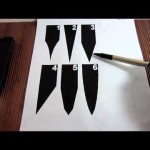
2cccd3f1ed4b15a43b7a5fb61760dab0
Knives are essential tools for a variety of tasks, from preparing food to cutting rope. The shape and design of a knife blade can have a significant impact on its performance. One of the most important aspects of a knife blade is its grind, which is the angle and shape of the blade’s edge. In this article, we’ll explore the different types of knife grinds and their uses. We’ll also discuss how to choose the right grind for your needs.
What are the different grinds on knives
Knives come in a variety of shapes and sizes, and the grind of a knife is one of the most important factors in determining its performance. The grind of a knife is the angle and shape of the blade’s edge, and it can have a major impact on how the knife performs. There are several different types of grinds, each with its own advantages and disadvantages.
Flat Grind
The flat grind is the most common type of grind and is found on most kitchen knives. It is created by grinding both sides of the blade in a straight line from the spine to the edge. This type of grind is easy to sharpen and provides a good balance between strength and sharpness.
Hollow Grind
The hollow grind is created by grinding the blade in a concave shape, creating a “V” shape. This type of grind is very sharp, but it is also more fragile than other grinds. It is best suited for slicing and cutting tasks.
Chisel Grind
The chisel grind is created by grinding one side of the blade in a straight line and the other side in a curved line. This type of grind is very strong and is best suited for chopping and slicing tasks. It is also easy to sharpen.
Convex Grind
The convex grind is created by grinding the blade in an outward curve from the spine to the edge. This type of grind is very strong and is best suited for heavy-duty tasks such as splitting wood. It is also very difficult to sharpen.
Scandinavian Grind
The Scandinavian grind is created by grinding the blade in a convex shape from the spine to the edge. This type of grind is very sharp and is best suited for slicing and cutting tasks. It is also easy to sharpen.
Conclusion
The type of grind on a knife can have a major impact on its performance. Different grinds are better suited for different tasks, so it is important to choose the right grind for the job. Knowing the different types of grinds and their advantages and disadvantages can help you make an informed decision when choosing a knife.
What is the most versatile knife grind
Knife grinds are the various shapes and angles that are ground into the blade of a knife. Different grinds are used for different purposes, and the most versatile grind is the one that can be used for a variety of tasks. The most versatile knife grind is the full flat grind, which is a single bevel that runs from the spine of the blade to the edge. This grind is great for slicing, chopping, and piercing, and it is also easy to sharpen.
The hollow grind is another popular grind that is often used for hunting and skinning knives. This grind is created by grinding the blade in a concave shape, which creates a very sharp edge. The hollow grind is great for slicing and skinning, but it is not as durable as the full flat grind.
The convex grind is a grind that is created by grinding the blade in a convex shape. This grind is great for chopping and slicing, and it is also very durable. The convex grind is not as sharp as the hollow grind, but it is still a great choice for a versatile knife.
The scandi grind is a grind that is created by grinding the blade in a flat shape with a slight curve. This grind is great for slicing and chopping, and it is also very easy to sharpen. The scandi grind is not as durable as the full flat grind, but it is still a great choice for a versatile knife.
No matter what type of knife you are looking for, there is a grind that will suit your needs. The full flat grind is the most versatile grind, but the hollow grind, convex grind, and scandi grind are all great choices for a versatile knife. Each grind has its own advantages and disadvantages, so it is important to choose the one that best suits your needs.
What is the sharpest blade grind
The sharpest blade grind is a term used to describe the shape of a blade’s edge. It is the angle at which the blade is ground, and it affects the sharpness of the blade. The sharper the angle, the sharper the blade will be. There are several different types of blade grinds, each with its own advantages and disadvantages.
Types of Blade Grinds
The most common types of blade grinds are the flat grind, hollow grind, and convex grind. The flat grind is the simplest and most common type of blade grind. It is created by grinding the blade in a single direction, creating a flat surface. This type of grind is good for general-purpose use, but it is not the sharpest.
The hollow grind is created by grinding the blade in a circular motion, creating a concave surface. This type of grind is very sharp, but it is not as durable as the flat grind. It is best used for slicing and cutting tasks.
The convex grind is created by grinding the blade in an arc, creating a convex surface. This type of grind is the sharpest of all the blade grinds, but it is also the least durable. It is best used for tasks that require a very sharp edge, such as skinning or butchering.
Choosing the Right Grind
When choosing a blade grind, it is important to consider the type of tasks you will be performing with the blade. If you need a blade for general-purpose use, then the flat grind is the best choice. If you need a blade for slicing and cutting tasks, then the hollow grind is the best choice. And if you need a blade for tasks that require a very sharp edge, then the convex grind is the best choice.
No matter which type of blade grind you choose, it is important to maintain the blade properly. This includes sharpening the blade regularly and keeping it clean and dry. With proper care, your blade will stay sharp and last for many years.
What is the best grind for a survival knife
When it comes to choosing the right grind for a survival knife, there are a few factors to consider. The grind of a knife is the shape of the blade, which affects its performance and durability. The most common grinds are flat, hollow, and convex. Each grind has its own advantages and disadvantages, so it’s important to choose the one that best suits your needs.
A flat grind is the most common grind for a survival knife. It is easy to sharpen and provides a good balance between strength and cutting ability. The downside is that it can be prone to chipping and can be difficult to sharpen in the field.
A hollow grind is a good choice for a survival knife because it is very sharp and easy to sharpen. It is also very strong and can handle tough tasks. The downside is that it can be prone to chipping and can be difficult to sharpen in the field.
A convex grind is a good choice for a survival knife because it is very strong and can handle tough tasks. It is also very sharp and easy to sharpen. The downside is that it can be difficult to sharpen in the field and can be prone to chipping.
When choosing the best grind for a survival knife, it is important to consider the type of tasks you will be using it for. If you are looking for a knife that can handle tough tasks, then a convex grind is a good choice. If you are looking for a knife that is easy to sharpen and maintain, then a flat or hollow grind is a better choice.
No matter which grind you choose, it is important to maintain your knife properly. This includes sharpening it regularly and keeping it clean and oiled. With proper care, your survival knife will last for many years.
We hope this article has been helpful in understanding the different types of knife grinds and their uses. We wish you the best of luck in finding the perfect knife for your needs. Goodbye and thank you for reading!













